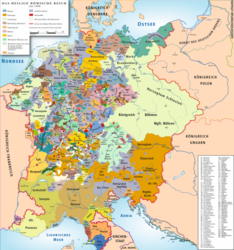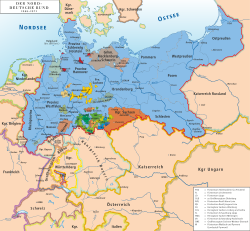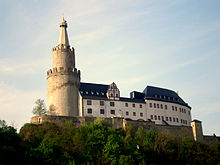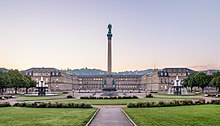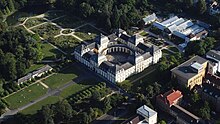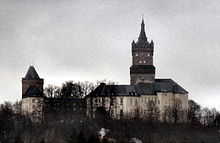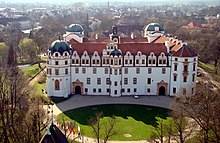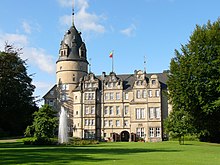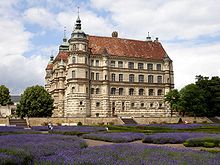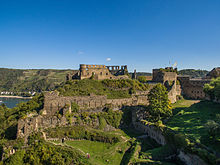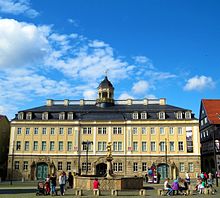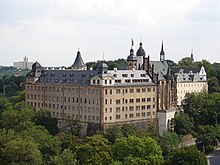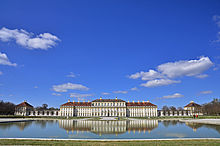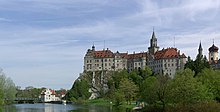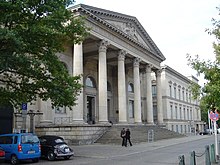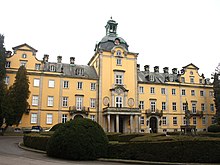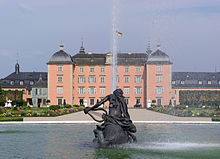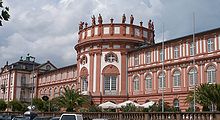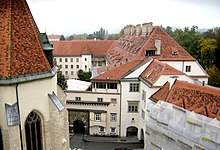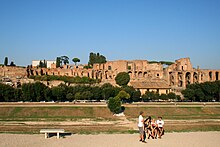Residential city

A residential city is an urban center that is the seat of a monarch or prince . In order to maintain monarchical rule , power had to be visible to subjects and embassies. This visualization of power is reflected in the architecture (for example in the form of castles and publicly representative buildings), but also in symbolic actions such as celebrations, entrances, parades and courtly ceremonies. A royal seat should legitimize the order and permanence of the respective rule .
Meaning and function
The meaning and function of the residential city is already implied in the term itself. The royal seat goes back etymologically to the Middle Latin term Residentia, which means something like residence. The word Residentia, in turn, has its origin in the verb residere , which can be translated as the word to sit. With the residence city is meant the official seat of a ruler. In contrast to the capital, the residential city does not necessarily have to be the undisputed political, administrative, scientific and cultural center of a state. A residential city is characterized solely by the presence of the monarch. The royal seat primarily serves to represent power. Economically, the residents of a royal seat can be dependent on the court, as can cultural or religious institutions. However, the last-mentioned characteristics are not mandatory criteria for a residential city.
According to Marc von der Höh, a residential city is characterized by a “permanent” and “permanent court” in a city. A brief presence of the ruler and court, as in the case of the travel kingship, is not enough to classify the place as a residential city. A “demarcated” seat of government as well as functional buildings for the ruler and his court must have developed. In economic, cultural and social terms, too, the development of town and residence must be closely intertwined.
Residence cities were or are common in all cultures from Rome via Constantinople / Byzantium, Baghdad to the imperial cities of China, Kyōto and Tokyo in Japan and cities like Tenochtitlan in the New World. These were mostly the dynasty's residences , but were taken over by the new ruler when the empire was taken over or conquered in order to express legitimacy and continuity and also a newly acquired higher rank. The relocation of the royal seat of an empire was - except in ancient China, where there was a religious motivation - mostly a question of the downgrading hierarchy of the territories in an empire.
There were no permanent residences in the European Middle Ages. Rather, the ruler moved from court camp to court camp. The royal entourage, which was responsible for the keeping and administration of a territory, was housed in castles , towns and, with kings, also in so-called palaces . The farm moved around because the farmers 'taxes in kind and the cities' money and taxes had to be collected in various places. The tribute of the stands and the jurisdiction had to take place on site. However, the further development of the urban system and the rise of the early capitalist money economy created the prerequisites for royal cities such as Prague , Vienna and Dresden in the late Middle Ages and the beginning of the early modern period . In addition to the main urban residence, which is increasingly located in the valley, there were occasionally visited summer residences such as Wilhelmsthal Castle , hunting castles such as Moritzburg Castle and country estates such as Paretz in the surrounding area. Both summer, hunting and country residences are not part of the residential cities, as either an urban settlement was missing or the presence of the ruler was only brief.
The new urban residences were mostly in the old medieval main castles of the cities (Holy Roman Empire: Hradschin in Prague, Viennese (court) castle ; France: Louvre ) or in the inner-city palaces (town houses) of the Renaissance period.

In the age of absolutism , the late 17th and 18th centuries, many princes moved their residence to the gates of their old capital. In contrast to the narrow, often still medieval-style streets of the cities, no consideration had to be given to the existing buildings in the countryside. There was enough space both for the creation of large parks and for representative buildings. New surveying instruments made a planned, orderly expansion of the new residential cities possible. The building program in Versailles near Paris , initiated by the French Sun King Louis XIV , was the model for all European royal cities of that time . Three central streets radiate from the Palace of Versailles towards the city. This allusion to the sun was intended to express that the monarch is at the center of the state. The city plan of Versailles, designed according to the rules of symmetry , axiality and centering , reflected the ruler's claim to represent a divinely inspired order . Baroque planned cities such as Karlsruhe , Ludwigsburg near Stuttgart, Ludwigslust near Schwerin and Potsdam near Berlin also emerged in Germany .
The residents of a royal seat often developed political awareness due to their relative proximity to the monarch, his government and authorities. With demonstrations, mass gatherings and riots they were able to exert an active influence on the politics of the rulers.
List of important residential cities in Europe
Former monarchies
Germany
A city culture and thus also an urban seat of power could only develop in the area of today's Federal Republic of Germany under the organization of the Roman Empire. The prerequisite for this was a restructuring of the Roman Empire under Emperor Diocletian (reign: 284 to 305 AD). The system of government he founded, the tetrarchy , divided the empire into four domains. Each of these four domains was subordinate to an emperor. Emperor Constantius I made Trier his seat of government. From here he was at the same time at a safe distance from the endangered Rhine border, but was also able to stabilize it quickly or respond to Germanic raids with campaigns.
After the fall of the Roman Empire , episcopal cities like Mainz and Cologne developed into urban rulers. The reason for this was the fact that the bishops increasingly succeeded in combining spiritual and secular offices with one another. They rose to become so-called imperial princes . In contrast to kings and other secular princes, in the Holy Roman Empire they had “permanent official seats” and an administrative convention that often dates back to Roman times. With Christianization , episcopal residence cities also expanded into areas that had never been part of the Roman Empire.
Cities with royal palaces such as Goslar or Gelnhausen are usually not counted among the residential cities. Although some stays over a longer period of time can be proven, the court offices did not settle permanently in one place. Apart from the royal palace itself, there were usually hardly any other representative mansion buildings. Only Aachen under Charlemagne can be seen as an exception . From 794 AD the king had Aachen expanded into the political center of the Frankish Empire . Administration, archive, court school and court library were given a permanent seat. In this way, Charlemagne imitated the capital city function of imperial Constantinople and ancient Rome. He thus underlined his claim to the dignity of the emperor. Of course, the successors of Charlemagne did not continue the tradition of a residence and capital.
Since the area of today's Federal Republic of Germany was divided into many individual states for centuries, there is an unusually high number of residential cities in almost all regions. The following maps show the territorial development within the Holy Roman Empire of the German Nation , the Rhine Confederation , the German Confederation , the North German Confederation and the German Empire and the end of the monarchy in Germany in 1918.
| Period | City name | description | Illustration |
|---|---|---|---|
|
286 AD to 392 AD (with interruptions) |
Trier or Augusta Treverorum |
Function : Seat of Western Roman emperors (e.g. Constantine I , Constantine II , Valentinian I , Gratian , Magnus Maximus )
Preserved buildings : Imperial baths , Constantine basilica and amphitheater Special feature : UNESCO World Heritage Site since 1986 Explanation : Probably already under Constantius Chlorus the foundations for the creation of an extensive palace district in the north-eastern area of the city area were laid. Former residential quarters that had existed there since the middle of the imperial era were demolished. From 306 AD, Emperor Constantine I continued the large-scale construction program of his predecessor: On the south side of the palace area, work began on one of the large public baths, the so-called Kaiserthermen . The palace auditorium (the so-called basilica ) was built around 350 m north of the Kaiserthermen as a representative core of the palace district. The approximately 67 m long and 27 m wide interior of this imperial throne room is considered to be the largest pillarless hall building of antiquity. Constantine I had the circus complex , which is probably to the east of the palace , expanded. As a venue, it was also a place of imperial representation and an integral part of late antique royal cities. |

Constantine basilica as the former reception hall of the imperial palace
|
| ? - 1803 | trier |
Function : Seat of the Electors of Trier
Preserved buildings : Trier Cathedral , Electoral Palace and Constantine Basilica |
|
| ? - 1803 | Mainz |
Function : Seat of the Electors of Mainz
Preserved buildings : Electoral Palace , Electoral Marstall , Citadel Mainz , Mainz Cathedral and Deutschhaus Mainz |
|
| ? -? | Cologne | Function : Seat of the Cologne Electors | |
| 739-1803 | Passau |
Function : Seat of the Prince-Bishop of Passau
Preserved buildings : Veste Oberhaus , St. Stephen's Cathedral , Prince-Bishop's Opera House and New Residence |
|
| 742-1803 | Wurzburg |
Function : seat of the Würzburg bishops
Special feature : Würzburg Residence with the Hofgarten and Residenzplatz, UNESCO World Heritage Site since 1981 Preserved buildings : Marienberg Fortress , Würzburg Cathedral and Würzburg Residence |
|
| 765-855 | Aachen |
Function : Aachen royal palace as the main residence of Charlemagne Special feature : Aachen Cathedral and Cathedral Treasure since 1978 UNESCO World Heritage Site Preserved buildings : Octagon of Aachen Cathedral, Granus Tower and remains of the foundations of the Palatinate under today's Aachen City Hall |
|
| 799-1802 / 1803 | Paderborn |
Function : Seat of the prince-bishops of Paderborn
Preserved buildings : Neuhaus Castle |
|
| 966-1803 | Quedlinburg |
Function : 966–1803 as the seat of the Quedlinburg Monastery
Special feature : UNESCO World Heritage Site since 1994 Structures preserved : St. Servatius Collegiate Church , Quedlinburg Collegiate Palace , ruins of St. Mary's Church |
|
| 1007-1803: | Bamberg |
Function : seat of the Bamberg bishopric
Special feature : UNESCO World Heritage Site since 1993 Preserved buildings : Old Court , New Residence and Bamberg Cathedral |
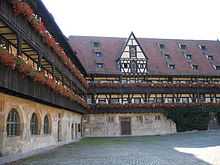
Inner courtyard of the old court
|
| 11th century to 1806 | Diez |
Function : Seat of the Counts of Nassau-Diez
Preserved buildings : Grafenschloss Diez , St. Maria and Schloss Oranienstein |
|
| 11th century to 1503 | Burghausen | Function : Residence of the Dukes of Bavaria-Landshut | |
| approx. 1100-1231 | Kelheim | Function : Residence town of the Wittelsbach family |

Herzogkasten , consisting of stone blocks from the demolished Kelheim Castle
|
| 1119-1864 | Schleswig |
Function : Seat of the Dukes of Schleswig and the Dukes of Schleswig-Holstein-Gottorf
Structures preserved : Gottorf Castle |
|
| 1131-1918 | Schwerin |
Function : Main residence of the Obotrite princes since 1131, and the dukes and grand dukes of Mecklenburg-Schwerin 1329–1918
Preserved buildings : Schwerin Palace , State Museum (grand ducal art collection) , Mecklenburg State Theater , Old Palais , Marstall , college building |
|
|
1142–1918 (with interruptions) |
Braunschweig |
Function : Seat of the Duchy of Saxony (1142–1195) and the Principality of Braunschweig-Wolfenbüttel (1267 / 1269–1430) and the Principality of Braunschweig-Wolfenbüttel (1753–1807), seat of the Duchy of Braunschweig (1814–1918)
Preserved structures : Dankwarderode Castle , Brunswick Cathedral , Brunswick Castle Lion , Duke Anton Ulrich Museum and Brunswick Palace |
|
| 1152-1680 | Hall | Function : Residence of the Magdeburg archbishops and their administrators | |
| 1153-1806 | Weikersheim | Function : Residence of the Lords of Hohenlohe , from 1450 Counts of Hohenlohe and from 1744 Princes of Hohenlohe | |
| 1163-1718 | Weida | Function : seat of the rebels of Weida and the margraves of Meissen | |
| 1182-1720 | Heidelberg |
Function . Seat of the Palatinate Electors
Preserved buildings : Heidelberg Castle , Karlstor and Marstall |
|
| 12th century to 1918 | Stuttgart |
Function : seat of the counts (12th century to 1495), then the dukes (1495–1806) and the kings of Württemberg (1806–1918)
Preserved buildings : Old Palace , New Palace , Solitude Palace , Jubilee Column , Sepulchral Chapel , Old State Gallery , Rosenstein Palace , Kronprinzenpalais , Villa Berg and Wilhelmspalais |
|
| 12th century to 1793 | Saarbrücken | Function : Seat of the Counts of Nassau-Saarbrücken | |
| 12th century to 1628/87 | Büdingen | Function : Seat of the Lords of Büdingen , the Counts of Ysenburg and Büdingen | |
| 12th century to 1726 | Dachau | Function : Residence of Bavarian dukes and electors | |
| around 1200 to 1816 | Ellwangen | Function. Seat of the prince provosts of Ellwangen and later Frederick I of Württemberg | |
| 1246-1787 | Tettnang | Function : residence of the Counts of Montfort | |
| 1255-1918 | Munich |
Function : Residence of the Bavarian dukes , electors and kings (1255–1918)
Preserved buildings : Nymphenburg Palace , Hofgarten , Munich Residence , Mariensäule , Alte Pinakothek , Alter Hof , Feldherrnhalle , Siegestor , State Library , Glyptothek , Propylaea , Collection of Antiquities , Hall of Fame , Cuvilliés Theater , Blutenburg Palace , Old Mint , Carmelite Church , Theatine Church and Fürsten Palace |
|
|
1260-1422 and 1486-1547 |
Wittenberg | Function: Seat of the Electors of Saxony-Wittenberg |

Wittenberg Castle Church and uncovering the foundation walls of the south wing (2011)
|
| 1269-1378 | Luneburg | Function : Seat of the Dukes of the Principality of Lüneburg | |
| ? -? | Tangermünde | Function : Residence of the Electors of Brandenburg | |
| from 1288 to? | Bonn | Function : Residence of the Electors of Kurköln | |
| 1291-1596 | Einbeck | Function: Seat of the Princes of Grubenhagen |
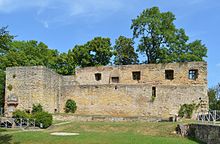
Salzderhelden Castle , Einbeck
|
| 1306-1918 | Greiz | Function: Seat of the Counts and Imperial Princes of Reuss | |
| 1347-1480 | Eltville | Function : residence of the Electors of Kurmainz | |
| ? -? | Putbus | Function : Residence of the lords of Putbus, who were historically equal to the princes of Rügan, from 1810 |

Putbus Castle around 1900, blown up in 1962, torn down until 1964
|
| 1355-1816 | Weilburg | Function : Seat of the counts, (imperial) princes and dukes of Nassau-Weilburg and later of the Duchy of Nassau |

Old town of Weilburg with castle complex
|
| around 1380-1716 | Dusseldorf | Function : Seat of the Dukes of Jülich-Berg (from around 1380), the Dukes of Jülich-Kleve-Berg (1521–1609), the Count Palatine Wolfgang Wilhelm (1614–1653), the Count Palatine and Elector Philipp Wilhelm (1653–1690) and Johann Wilhelm (1690–1716) | |
| 1390-1918 | Lichtenstein | Function : residence of the counts, dukes and kings of Württemberg | |
| 1396-1918 | Dessau | Function : Seat of the Princes of Anhalt-Dessau | |
| 1417-1813 | Kleve | Function: Seat of the Dukes of Kleve | |
| 1430-1753 | Wolfenbüttel | Function : Seat of the Dukes of the Principality of Braunschweig-Wolfenbüttel | |
| 1433-1705 | Celle | Function : Residence of the Dukes of the Principality of Lüneburg | |
| 1443-1482 | Bad Urach |
Function : Residence of the Dukes of Württemberg-Urach
Structures : Urach Castle , St. Amandus , Haus am Gorisbrunnen (accommodation for guests of the farm) and Marktbrunnen |
|
| 1448-1918 | Berlin -Cölln / Berlin |
Function : Residence town of the Brandenburg margraves and electors , kings in / of Prussia since 1701/1772, the emperor of the German Empire (1871–1918)
Buildings : City Palace , Palace Square , Schloss Charlottenburg , Mausoleum at Charlottenburg Palace , Crown Prince's Palace , Schloss Friedrichsfelde , Glienicke Palace , Schönhausen Palace , Castle on Peacock Island , Brandenburg Gate , Arsenal , Berlin Cathedral , Museum Island , National Monument to the War of Liberation , Belvedere , Neue Wache , Playhouse , State Opera , St. Hedwig's Cathedral , Royal Library |
|
| 1470-1793 | Zweibrücken | Function : seat of the dukes of Pfalz-Zweibrücken | |
| 1483-1601 | Torgau | Function : residence of the Saxon electors | |
| 1485-1918 | Dresden |
Function: seat of the electors and kings of Saxony
Structures : Residenzschloss , Goldener Reiter , Japanese Palais , Pillnitz Castle , Zwinger (Dresden) , Great Garden (Dresden) , Catholic Court Church , Palais Brühl-Marcolini , Stallhof , Royal Saxon Court Theater and Coselpalais |
|
| 1491-1581 | Römhild | Function : Seat of the Counts of Henneberg-Römhild | |
| 1505-1742 | Neuburg | Function : Residence town of Pfalz-Neuburg | |
| 1514-1545 | Landshut | Function: Residence city of the Bavarian Duke Ludwig X. | |
| 1526 / 27-1809 | Mergentheim | Function: Seat of the Grand Master of the Teutonic Order | |
| 1526-1803 | Meersburg | Function : seat of the prince-bishops of Constance | |
| 1528-1918 | Detmold | Function : Seat of the (imperial) counts and princes of Lippe | |
| 1541-1803 | Aschaffenburg | Function : Second residence of the Electors of Kurmainz | |
| 1552-1918 | Weimar | Function : Seat of the Dukes of Saxe-Weimar , later of Saxe-Weimar-Eisenach | |
| 1556-1695 | Guestrow | Function: Seat of the Dukes of Mecklenburg | |
| 1561-1761 | Plön | Function : Seat of the Dukes of Schleswig-Holstein-Sonderburg-Plön | |
| 1564-1802 | Gera | Function: Capital of the Principality of Reuss Younger Line |

Remains of Osterstein Castle
|
| 1565-1718 | Durlach |
Function : Residence of the Margraves of Baden-Durlach . Preserved structures : Karlsburg Castle |

Karlsburg ; in front the so-called princess building
|
| 1567-1866 | kassel | Function : Seat of the Landgraves of Hesse-Kassel (1567–1803) and the Electors of Hesse (1803–1866) | |
| 1567-1918 | Darmstadt | Function : Seat of the Landgraves of Hesse-Darmstadt (1567–1806) and the Grand Dukes of Hesse (1806–1918) | |
| 1567-1604 | Marburg | Function : Seat of the Landgraves of Hesse-Marburg | |
| 1567-1583 | St. Goar | Function : Seat of the Landgraves of Hesse-Rheinfels | |
| 1586-1633 | Coburg | Function: Seat of the Duchy of Saxony-Coburg and Gotha and the Coburg dukes | |
| 1596-1918 | Eisenach | Function : Capital of Saxony-Eisenach until 1741, then secondary residence of Saxony-Weimar-Eisenach until 1918 | |
|
1597–1794 (official) |
Bonn | Function : Residence of the Electors of Kurköln | |
| 1599-1918 | Sondershausen | Function : Capital of the Principality of Schwarzburg-Sondershausen | |
| 1599-1918 | Rudolstadt | Function : Residence of the Principality of Schwarzburg-Rudolstadt | |
| 1603-1918 | Altenburg | Function : Capital of the Duchy of Saxony-Altenburg (1603–1672 and 1826–1918) | |
| 1603-1806 | Bayreuth | Function : Residence of the Margraves of Bayreuth | |
| 1609-1643 | Butzbach | Function : Residence of Landgrave Philip III. from Hessen-Butzbach | |
| 1616 to the beginning of the 18th century | Oberschleissheim | Function : Residence of the Bavarian Electors | |
| 1623-1849 | Sigmaringen | Function : Residence of the Princes of Hohenzollern-Sigmaringen | |
| 1623-1850 | Hechingen | Function : Residence of the Princes of Hohenzollern-Hechingen | |
| 1629-1786 | Ehrenbreitstein | Function : Residence of the Elector of Trier | |
| 1631-1815 | Offenbach am Main | Function : Seat of the Earls of Isenburg-Offenbach (1631-1685), Isenburg-Birstein (1685-1806, since 1744 Prince) and the sovereign Rheinbund -Fürsten to Isenburg (1806-1815) | |
| 1636-1866 | Hanover | Function : Seat of the Principality of Calenberg-Göttingen (1636–1692), the Electorate of Braunschweig-Lüneburg (1692–1814) and the Kingdom of Hanover (1814–1866) | |
| 1640-1918 | Gotha | Function : Seat of the Dukes of Saxe-Gotha (since 1826 in personal union with Saxe-Coburg) | |
| 1647-1918 | Buckeburg | Function : Seat of the Counts and Princes of Schaumburg-Lippe | |
| 1652-1802 | Oranienburg | Function : Residence of the Brandenburg margraves and electors , kings in / of Prussia since 1701/1772 | |
| 1655-1918 | Arolsen | Function : Residence of the Counts and Princes of Waldeck- Pyrmont | |
| 1656 / 57-1718 | Time | Function : Residence of the Dukes of Saxony-Zeitz | |
| 1660-1918 | Potsdam |
Function : Residence of the Electors of Brandenburg, Kings in / of Prussia (1701–1918), Residence of the German Emperors from 1871 to 1918
surviving building : Hunting Lodge star , Dutch Quarter , City Palace , Sanssouci Palace , Gallery , Chinese House , Old Market , New Market , Historic Mill of Sanssouci , Belvedere on the Klausberg , New Palace , Brandenburg Gate , Marble Palace , New Garden , Charlottenhof Palace , Roman baths , peace Church , Ruinenberg , dragon house , Dampfmaschinenhaus , Dampfmaschinenhaus , Old Town Hall , St. Nikolai , Belvedere , Gothic library , dairy in the new garden , shell grotto in the new garden , hermitage at Potsdamer Jungfernsee , Cecilienhof , Babelsberg , Babelsberg Palace , Castle Sacrow , Pomona Temple , Lindstedt Castle and the Marstall of the City Palace |
|
| 1680-1918 | Meiningen |
Function : Seat of the Dukes of Saxony-Meiningen (including Duke Georg II / theater reform)
Preserved buildings : Residenzschloss Schloss Elisabethenburg , Marstall , Reithalle , Großes Palais , Kleines Palais , Schloss Landsberg , Meierei am Landsberg , Meininger State Theater , Palais am Prinzenberg and the ducal crypt chapel |
|
| 1682-1918 | King Wusterhausen | Function : summer residence of the Brandenburg margraves and electors , kings in / of Prussia since 1701/1772, the emperors of the German Empire (1871–1918) | |
| 1684-1826 | Hildburghausen | Function : Seat of the Dukes of Saxony-Hildburghausen |

Hildburghausen Palace , demolished in 1949/1950
|
| 1684-1710 | Römhild | Function : Seat of the Duke of Saxony-Römhild | |
| 1687-1806 | Büdingen | Function : Residence of the County of Ysenburg and Büdingen in Büdingen | |
| 1687-1806 | Sea wood | Function : Seat of the Counts of "Ysenburg and Büdingen in Meerholz" | |
| 1687-1724 | Marienborn | Function : Seat of the Counts of "Ysenburg and Büdingen in Marienborn" | |
| 1687-1806 | Waechtersbach | Function : Seat of the "Counts of Ysenburg and Büdingen in Wächtersbach" | |
| 1688-1806 | Bartenstein (Schrozberg) |
Function: Residence of the counts and later princes of Hohenlohe-Bartenstein including court.
Special feature: Probably the smallest planned and self-contained, rural residential town with a castle and officials' houses from the Baroque period in Germany. The historic town center and the overall baroque impression have been largely preserved and are under general protection . |
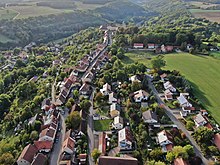
Bartenstein with the main axis, city gate and courtyard garden oriented towards the residential palace
|
| 1689 to the end of the 18th century. | Schwedt | Function : Residence town of Brandenburg-Schwedt | |
| 1705-1771 | Rastatt |
Function : Residence town of the Margraviate of Baden-Baden
Special feature : due to the destruction of the residential city of Baden-Baden during the War of the Palatinate Succession, the residence was relocated under Margrave Ludwig Wilhelm to Rastatt , the oldest baroque residence on the Upper Rhine, expanded as planned. Buildings Received : Residenzschloss Rastatt , Schloss Favorite , Einsiedeln Chapel , Pagodenburg and Rossi House |
|
| 1709-1816 | Ludwigsburg |
Function : New establishment, alternating with Stuttgart Residenz von Württemberg
Special feature : urban layout planned on the drawing board Preserved structures : Residenzschloss Ludwigsburg as the largest undestroyed baroque palace in Germany, hunting and pleasure palace Favorite , Schloss Monrepos , market fountain , French horn , palace theater and city church Ludwigsburg |
|
| 1715-1918 | Karlsruhe |
Function : Residence of the Margraviate of Baden-Durlach , from 1771 of the Margraviate of Baden , 1806–1918 of the Grand Duchy of Baden
Preserved buildings : Karlsruhe Palace , Palace Gardens , Karlsruhe Palace Square , Sweden Palace , Karlsruhe Pyramid , Evangelical City Church , Margravial Palace and the Pheasant Castle |
|
| 1720-1778 | Mannheim | Function : Seat of the Palatinate Electors | |
| 1720-1803 | Bruchsal | Function : Residence of the Prince-Bishops of Speyer | |
| 1725-1801 | Bruehl | Function : Summer residence of the Prince-Bishops of Cologne | |
| 1733-1918 | Neustrelitz | Function : Main residence of Mecklenburg-Strelitz | |
| 1736-1802 | Rheinsberg | Function : Residence of the kings in / of Prussia | |
| 1742-1803 | Schwetzingen | Function : Summer residence of the Electoral Palatinate | |
| 1744-1841 | Biebrich | Function : Residence of the Dukes of Nassau , seat of the Dukes from 1817 | |
| 1765-1837 | Ludwigslust |
Function : Seat of the Dukes of Mecklenburg-Schwerin
Structures: Ludwigslust Palace , Hofkirche , Helenen-Paulownen-Mausoleum , Louisen-Mausoleum , St. Helena and Andreas , Ludwigslust Canal |
|
| 1768-1806 | Bad Homburg vor der Höhe | Function : Residence of the Landgraviate of Hessen-Homburg | |
| 1769-1817 | Woerlitz | Function : Residence of Leopold III. Friedrich Franz von Anhalt – Dessau | |
| 1773-1775 | Blieskastel | under Franz Carl von der Leyen | |
| 1774-1918 | Oldenburg | Function : Seat of the dukes (1774–1810) and grand dukes (1815–1918) of Oldenburg | |
| 1786-1803 | trier | Function : seat of the Trier electors | |
| 1786-1794 | Koblenz | Function : seat of the Trier electors | |
| 1806-1813 | Dusseldorf | Function : Seat of the Grand Dukes of Berg | |
| 1815-1866 | Bad Homburg vor der Höhe | Function : Residence of the Landgraviate of Hessen-Homburg |

Bad Homburg Castle with the White Tower
|
| 1841-1866 | Wiesbaden | Function : Seat of the Dukes of Nassau |
Austria
| Period | City name | description | Illustration |
|---|---|---|---|
| Early 10th century until 1246 | Steyr | Function : Seat of the Dukes of Austria under the Babenbergs |

The Styraburg from a city view from 1554
|
| 1278-1918 | Vienna |
Function: Residence of the Roman-German Emperor (1278–1806, with interruptions), the Austrian Emperor (1804–1867, 1867–1918), the Apostolic King of Hungary (1867–1918),
as well as the Archdukes of Austria |
|
| 1379-1619 | Graz | Function: Residence city of Inner Austria | |
| 1410-1665 | innsbruck | Function: royal seat of Upper Austria | |
| 696-1805 | Salzburg | Function: residence of the prince archbishops , then for a short time electoral seat |
France
| Period | City name | description | Illustration |
|---|---|---|---|
| 4th century – 1444 1681–1789, 1889–1918 | Strasbourg |
Function : capital of the prince-bishops of Strasbourg and later brief residence of Kaiser Wilhelm II.
Remaining buildings : Palais Rohan , Strasbourg Cathedral and Palais du Rhin |
|
|
843-1661, 1789-1792, 1799-1848, 1852-1870 |
Paris |
Function : Capital of the West Franconian and later French kings / emperors
Existing buildings : Conciergerie , Louvre , Palais du Luxembourg , Jardin des Tuileries , Palais Royal , Hôtel Beauharnais , Vincennes Castle , Chapelle expiatoire , Sainte-Chapelle , Place des Victoires , Place Vendôme , Place de la Concorde , Champs-Élysées , Porte Saint- Denis , Hôtel des Invalides , Invalides , Paris Observatory and Panthéon , |

Conciergerie , rest of the medieval residence
|
|
843-1789, 1804-1848, 1852-1870 |
Compiegne | Function : Residence of the West Franconian and later French kings / emperors | |
| 1417-1789 | Saverne | Function : Residence of the Prince-Bishops of Strasbourg | |
| 1483-1563 | Amboise | Function : residence of the French kings | |
| 1498-1589 | Blois | Function : residence of the French kings | |
|
1528-1789, 1804-1848, 1852-1870 |
Fontainebleau | Function : residence of the French kings and emperors | |
| 1661-1682 | Saint-Germain-en-Laye | Function : temporary capital under Louis XIV. | |
| 1682-1789 | Versailles |
Function : Residence of the French kings Louis XIV. , Louis XV. and Louis XVI.
Special feature : high point of baroque architecture, model for the royal courts of Europe Status : since 1979 World Heritage Site by UNESCO Preserved buildings : Versailles Palace , Petit Trianon , Grand Trianon , Hameau de la Reine , Saint-Louis Cathedral and Place d'Armes |
|
| 1828-1848 | Eu | Function : Residence of Louis-Philippe I. |
Italy
| Period | City name | description | Illustration |
|---|---|---|---|
| 27 BC Chr. To 402 AD | Rome | Function : main residence of the Roman emperors | |
| 402-476 | Ravenna | Function : Main residence of the Western Roman emperors |

Exterior view of the mausoleum of Galla Placidia
|
| 493-552 | Ravenna | Function : residence of the Ostrogothic kings | |
| 572-774 | Pavia | Function : seat of the Lombard kings | |
| 697-1797 | Venice | Function: Seat of the Doges of the Republic of Venice | |
| 831-1053 | Palermo | Function : Residence of the Kalbite dynasty as emirs of Sicily | |
| 1071-1266 | Palermo | Function : Residence of the Norman-Staufer Sicily | |
| 1234-1631 | Urbino | Function : Residence of the Counts and Dukes of Urbino |

Arcaded courtyard of the Palazzo Ducale
|
| 1264-1597 | Ferrara | Function : Seat of the Dukes of Ferrara | |
| 1266-1861 | Naples | Function : Residence of the Kings of Naples and Kings of the Two Sicilies | |
| 1395-1535 | Milan | Function : Seat of the Duke of Milan | |
| 1597-1796 | Modena | Function : Seat of the Dukes of Modena | |
| 1861-1864 | Turin | Function : Residence of the Kingdom of Italy | |
| 1864-1871 | Florence | Function : Residence of the Kingdom of Italy | |
| 1871-1946 | Rome | Function : Residence of the Kingdom of Italy |
Russia
| Period | City name | description | Illustration |
|---|---|---|---|
|
1340-1712, 1728-1730 |
Moscow | Function : Capital of the Grand Dukes of Moscow and the Tsars | |
| 1710-1917 | Pushkin | Function : summer residence of the tsars | |
|
1712-1721, 1730-1917 |
St. Petersburg | Function : capital of the tsars |

The Hermitage
|
| 1723-1917 | Petershof | Function : secondary residence of the tsars | |
| 1796-1917 | Pavlovsk | Function : secondary residence of the tsars |
Czech Republic
| Period | City name | description | Illustration |
|---|---|---|---|
| 1234-1918 | Prague |
Function : residence of the kings of Bohemia
Buildings: Prague Castle , St. Vitus Cathedral , Charles Bridge , Prague Powder Tower , St. Mary of the Snow |
Existing monarchies
Spain
| Period | City name | description | Illustration |
|---|---|---|---|
| 756-1031 | Cordoba | Function : Capital of the Caliphate of Cordoba | |
| 1023 – today | Seville | Function : Residence of the Abbadid dynasty and later the Spanish kings | |
| 13-15 Century | Segovia | Function : residence of the kings of Castile | |
| 1238-1492 | Granada | Function : Capital of the Naṣrid Sultanate | |
| 1469-1561 | Valladolid | Function : residence of the Spanish kings | |
| 1563-1861 | San Lorenzo de El Escorial | Function : residence of the Spanish kings | |
|
1561–1600, 1606 – today |
Madrid | Function : residence of the Spanish kings | |
| 1720-19. Century | San Ildefonso | Function : residence of the Spanish kings |
United Kingdom
| Period | City name | description | Illustration |
|---|---|---|---|
| 686-1066 | Winchester | Function : Capital of the Kingdom of Wessex and later England |
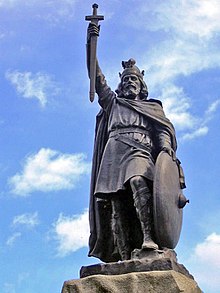
Alfred the Great statue in Winchester
|
| 1066 – today | London |
Function : Residence of the Kings of England and Great Britain
Remaining buildings : St James's Palace (official residence since 1532), Buckingham Palace in London (since 1837), Tower of London |
|
| 1078 – today | Windsor | Function : summer residence of the kings of England and Great Britain | |
| 1437 – today | Edinburgh | Function : residence of the kings of Scotland and later Great Britain |
Netherlands
| Period | City name | description | Illustration |
|---|---|---|---|
|
1248–1806, 1810 – today |
The hague | Function : capital of the Counts of Holland , governor of the Republic of the Seven United Provinces and kings of the Netherlands |

Paleis Noordeinde , the official seat of the Dutch monarchy
|
| 1638 – today | Baarn | Function : Residence of the Governor Republic of the Seven United Provinces , Kings of Holland and Kings of the Netherlands | |
| 1689-1975 | Apeldoorn | Function : Summer residence of the Governor Republic of the Seven United Provinces and the Kings of the Netherlands | |
| 1806 – today | Amsterdam | Function : residence of the kings of Holland (1806–1810) and kings of the United Netherlands (1815–1839) and the Netherlands |
Belgium
| Period | City name | description | Illustration |
|---|---|---|---|
| 1830 – today | Brussels | Function : residence of the kings of the Belgians | |
| 1865 – today | Ciergnon | Function : summer residence of the kings of the Belgians | |
| ? - today | Sheets | Function : residence of the kings of the Belgians |
Sweden
| Period | City name | description | Illustration |
|---|---|---|---|
| 1523 – today | Stockholm |
Function : residence of the kings of Sweden
Structures : Royal Castle |
Denmark
| Period | City name | description | Illustration |
|---|---|---|---|
| ?-today | Copenhagen |
Function: residence of the kings of Denmark
Structures : Amalienborg Palace |
Norway
- Royal Palace in Christiania / Oslo (since 1905, previously the secondary residence of the Swedish kings)
- Other residences: Bygdøy Kongsgård , Stiftsgården , Oscarshall and Skaugum
Liechtenstein
- Vaduz Castle in Vaduz (since 1939)
Luxembourg
- Berg Castle in Colmar-Berg (with interruptions since 1911)
- Betzdorf Castle (1953–1964)
Monaco
Vatican
- Apostolic Palace , official residence of the Pope in Vatican City
Montenegro
- Cetinje , the tiny capital of the Principality , Principality and Kingdom of Montenegro (1878 to January 25, 1916) was the royal residence and throne city
List of important residential cities in Africa
Former monarchies
Egypt
| Period | City name | description | Illustration |
|---|---|---|---|
| 2135–1985 BC Chr | Thebes |
Function : residence of the pharaohs
|

The Ramesseum
|
| 1353-1332 BC Chr. | Achet-aton | Function : residence of the pharaohs | |
| 1279-1078 BC Chr. | Pi-Ramesse | Function: residence of the pharaohs | |
| 323 BC Chr. – 30 AD | Alexandria | Function : residence of the Ptolomies |
Ethiopia
- Gonder , seat of the Negus Negest (1636–1889)
- Addis Ababa , seat of the Negus Negest (1889–1974)
Existing monarchies
Cameroon
Morocco
List of important residential cities in Asia
Former monarchies
Kingdom of Jerusalem
- Jerusalem , seat of the king (1099–1187, 1229–1244)
- Akkon , Coming and Palace of the Grand Master of St. John (1271–1291) and seat of the Grand Master of the Teutonic Order (1099–1291)
Existing monarchies
Bahrain
- Manama , residence of King Hamad of Bahrain (since 2002)
Bhutan
- Dechencholing Palace in Thimpu , residence of the King of Bhutan
Brunei
- Istana Nurul Iman Palace in Bandar Seri Begawan , seat of the Sultan of Brunei
Japan
- Imperial Palace in Tōkyō , seat of the Tennō (since 1868)
- Heian-kyō ( Kyōto ), seat of the Tennō and imperial court (794–1868)
- Heijō-kyō ( Nara ), seat of the Tennō (710–784)
- Kamakura , seat of the Kamakura shogunate (1192-1333)
- Muromachi (Kyōto), seat of the Ashikaga shogunate (1338–1568)
- Edo or (Tōkyō), seat of the Tokugawa Shōgunate (1603–1868)
Cambodia
- Phnom Penh , residence of King Norodom Sihamoni of Cambodia (again since 2004)
Saudi Arabia
- Riyadh , capital of the kings of Saudi Arabia (since 1932)
Thailand
- Grand Palace in Bangkok , residence of the kings of Thailand (until 1946)
- Chitralada Palace in Bangkok , residence since 1946
Oman
List of important residential cities in Oceania
Tonga
- Nukuʻalofa , capital of the kings of Tonga (since 1845)
See also
Web links
- Research project “Courtyard and Residence in the Late Medieval German Empire (1200–1600)” of the Göttingen Academy of Sciences
- Research project “Residential cities in the Old Kingdom (1300–1800). Urbanity in the integrative and competing relational structure of rule and community "of the Academy of Sciences in Göttingen
Remarks
- ^ During the personal union between Great Britain and Hanover from 1714 to 1837, the electors and kings of Hanover resided in Great Britain.
Individual evidence
- ^ Hans Ulrich Thamer: Everyday life in Berlin. 19th century. Elsengold. Berlin 2017, ISBN 978-3-944594-75-0 , p. 59.
- ^ Mirko Novák: Form of rule and urban architecture. Program in the Mesopotamian residential city building from Agade to Surra Man Ra'a. Saarbrücken 1999, pp. 56-57.
- ↑ Marc von der Höh: For the introduction, in: Symbolic interaction in the royal seat of the late Middle Ages and the early modern times, ed. by Gerrit Deutschländer / Marc von der Höh / Andreas Ranft, Berlin 2013, pp. 9–26, here: p. 11.
- ↑ Karl Czok: August the Strong and his time. Elector of Saxony, King of Poland . Piper. Munich 2006, ISBN 978-3-8289-0574-0 , p. 10.
- ↑ Karin Stober: Sun, State and Spider. The Karlsruhe plan from the Jagdstern to the sports park. In: Karl Wilhelm 1679–1738: Margrave of Baden-Durlach. Hirmer. Munich 2015, p. 121.
- ^ Manfred Gailus, Street and Bread. Social protest in the German states with special consideration of Prussia 1847–1849, Göttingen 1990, p. 96.
- ^ Frank Unruh: Trier. Biography of a Roman city. From Augusta Treverorum to Treveris. Scientific Book Society, Darmstadt 2017, pp. 59–60.
- ↑ Caspar Ehlers: How ambulatory to resident rule has developed, in: Jussen, Bernhard (ed.), Die Macht des König. Rule in Europe from the early Middle Ages to modern times, Beck, Munich 2005, pp. 106–124, here: pp. 117–118.
- ↑ Caspar Ehlers: How ambulatory to resident rule has developed, in: Jussen, Bernhard (ed.), Die Macht des König. Rule in Europe from the early Middle Ages to the modern age, Beck, Munich 2005, pp. 106–124, here: pp. 113–114.
- ↑ Stefan Weinfurter : Karl der Große: Der heilige Barbar, Piper, Munich / Zurich 2013, pp. 151–152.
- ↑ Caspar Ehlers: How ambulatory to resident rule has developed, in: Jussen, Bernhard (ed.), Die Macht des König. Rule in Europe from the early Middle Ages to the modern age, Beck, Munich 2005, pp. 106–124, here: p. 114.
- ^ A b Marcus Reuter: A Dream of Rome: City Life in Roman Germany . Ed .: Rheinisches Landesmuseum Trier. Theiss, Darmstadt 2014, ISBN 978-3-8062-2887-8 , pp. 108 .


